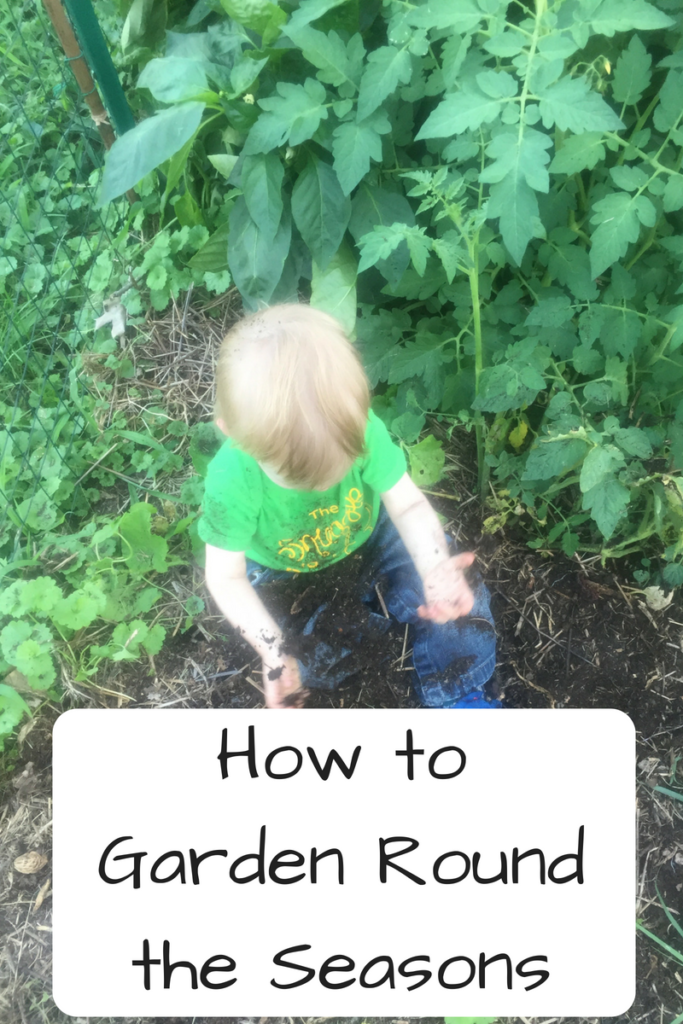
My beans have wilted, either from the slugs slurping on them or the sun beating down on them. Random holes in my garden are a testament to the birds digging for worms. The squash leaves are full of nibbles. Every year around late spring, I begin to despair about my garden.
Yet every late summer and fall, we have produce fresh from the backyard. (Sometimes bountiful, sometimes less so.) At the end of every year, I find growing my garden worthwhile. It brings our food miles down to zero, ensures my food is totally organic, stores carbon in the soil, creates habitat for animals, and is a wonderful way to bond with my kids.
But how do we go from those spring days to the (semi)-successful harvests? The whole process starts in the winter.
Winter
My gardening cycle begins when the first seed catalog shows up in our mailbox. Bright and colorful when the ground outside is brown, the pages tempt me with descriptions of delicious vegetables.
We order from Southern Exposure Seed Exchange, which offers organic and heirloom seeds cultivated for the Southeastern U.S. Other heirloom seed companies specialize in other parts of the country and world. Many places also have seed exchanges, where gardeners can share seeds they’ve saved from their own plants.
For the past few years, I’ve sat down with my older son. Together, we made a list and put in our order. (Learn more about how to plan a garden with your kids!)
Once the seeds arrive – usually in late February or March – we start our seed starting process. For seeds that must be started indoors – mainly tomatoes and peppers – we plant them in small pots. We mainly use recycled yogurt pint containers that I’ve punched holes in the bottom of. Both kids enthusiastically participate in this process. They love plunging their hands into the mud.
Afterwards, we place the plants under a home-built indoor growing set-up. While you can buy expensive sets from gardening catalogs, you can easily make your own as long as you have a shelf where you can hang a light fixture above it.
Spring
As the ground warms, we ready the plants and garden for planting.
As the sprouts get bigger, I separate them into new pots so they have room to grow. (Usually way later than I should!)
Of course, we also water them every day. In theory, this is my son’s job, but my husband and I always back him up. Both kids enjoy “petting” the plants, which mimics the wind and toughens them up. About a week before planting the seedlings, we leave them outside for a little longer each day. Just like kids, seedlings don’t handle abrupt change well.
In the spring, composting really takes off again. We compost through the winter, but nothing breaks down. Plus, we tend to eat fewer fresh fruits and vegetables in the winter than when they’re available from our community supported agriculture farm box in the spring and summer.
Summer
By now, there’s little else in our garden to do but water every day. Our weeding is minimal because of the lasagna gardening technique that we do (more on that in a minute).
It’s mainly a matter of harvesting the vegetables as they come along. The main issue is keeping an eye on our kids to ensure they don’t eat the green tomatoes. And fobbing the extra cherry tomatoes off on my co-workers.
During this time, our kids spend a lot of time just messing around in the backyard. In addition to our water table, we built them a raised bed for a children’s garden. Right now, it’s mainly dirt for them to dig in. And let’s be realistic, throw at each other. There are also some sunflowers that my older son originally sprouted in preschool. As the kids get older, I hope they’ll plant their own plants in their garden.
Fall
While most people think of garden prep in the spring, the majority of mine comes in the fall. Besides the typical ripping out of dead plants, we also do all of our preparation of the ground for the next year.
I do what’s called lasagna gardening or layer composting. With this method, we mimic the forest floor by piling up layers of organic matter. Starting with a layer of cardboard to suppress weeds, we add newspaper, compost, and leaves to the entire garden. By the end, the entire thing should be a few feet high! There are two major advantages to this method: it builds the soil wonderfully and minimizes invading weeds.
And then the cycle starts all over again. While the discouragement may come back around, so will the joy and eventually, the delicious vegetables.
A slightly different version of this post was originally posted on The Green Mama. For more on gardening, check out The Truth About Gardening with Young Children. If you are looking for a like-minded community, be sure to follow our Green and Sustainable Parenting Facebook group!